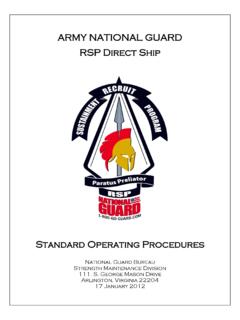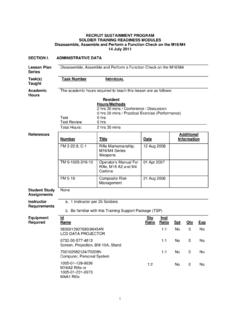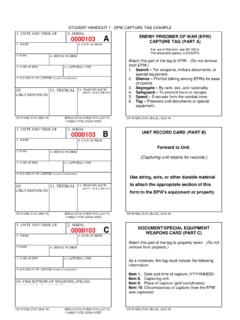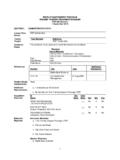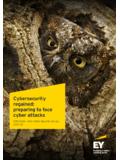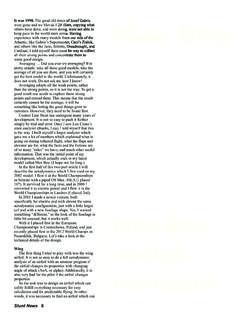Transcription of BATTLE DRILL 1A CONDUCT SQUAD ATTACK - …
1 Center for Army Lessons LearnedBATTLE DRILL 1 ACONDUCT SQUAD ATTACKTASK. CONDUCT SQUAD ATTACK (7-4-D101).CONDITIONS. The SQUAD is moving as part of a platoon conducting a movement to contact orhasty or deliberate ATTACK . The enemy has indirect fire and CAS 1. The SQUAD is not surprised or fixed by the SQUAD members locate and engage known or suspected enemy positions with well-aimed The SQUAD kills, captures, or forces the withdrawal of the Action on Enemy Soldiers receiving fire take up the nearest positions that afford them protection fromenemy fire (cover) and observation (concealment).b. The fire team in contact immediately returns a heavy volume of suppressive fire in thedirection of the enemy. It attempts to achieve suppressive fires. The team providing suppressivefires marks its flanks by throwing ir chemlight bundles or ir flares and continues to use AN/PVS-7 Band AN/PAQ-4 to place well-aimed, accurate fires on the enemy. The SQUAD employs M203 andhand-held ir smoke to screen the assaulting team's movement.
2 (1) Soldiers in the fire team in contact move to positions (bound or crawl) from which theycan fire their weapons, and position themselves to ensure they have observation, fields of fire, cover,and concealment. They continue to fire and report known or suspected enemy positions to the fireteam leader.(2) The team leader directs fires using tracers, AN/PAQ-4, or standard fire commands.(3) The fire team not in contact takes covered and concealed positions in place and observesto the flanks and rear of the SQUAD using night vision goggles and sights.(4) The SQUAD leader assesses the situation. He reports contact to the platoon leader andmoves toward the fire team in for Army Lessons Learned2. Locate the Using AN/PVS-7B, AN/PVS-4, AN/PAQ-4 and ir flares, the fire team in contact acquiresknown and suspected enemy position(s).b. The fire team leader in contact begins to facilitate C2 by directing fires with his AN/PAQ-4and tracers. He directs his team to mark the flanks by throwing ir chemlight bundles or ir flares tohelp the trail fire team SEE the location of friendly The SQUAD leader uses his AN/PVS-7B to help him see as he moves into a position wherehe can observe the enemy and can assess the situation.
3 He uses his hand-held laser pointer toilluminate the objective area to identify key enemy positions (based on MTETT). He uses irillumination (hand-held or mortars) to silhouette the enemy The SQUAD leader requests, through the platoon leader, immediate suppression The SQUAD leader reports the size and location, and any other information to the Suppress the The SQUAD leader determines if the fire team in contact can gain suppressive fire based onthe volume and accuracy of enemy fire. If the answer is yes, the fire team continues to suppress theenemy.(1) The fire team destroys or suppresses enemy crew-served weapons first. The fire teamleader identifies enemy positions and controls his fire team using the AN/PAQ-4 and/or tracers. Heilluminates the target area using hand-held ir flares (MTETT).(2) The fire team leader continues to control fires using AN/PAQ-4 and standard firecommands. Soldiers use AN/PVS-7Bs and AN/PVS-4s to deliver sustained, well-aimed fires.
4 (3) Buddy teams fire so that they are not reloading at the same If the answer is no, the SQUAD leader then deploys the fire team not in contact with theenemy to establish a support by fire position. He reports to the platoon leader. Normally, the squadwill become the base of fire element for the platoon. The SQUAD continues to shoot well-aimed firesat the enemy and responds to orders from the platoon leader. (The platoon leader, his RTO, theplatoon FO, one machine gun team, the SQUAD leader of the next SQUAD , as well as the weapons squadleader and the other machine gun team, are already moving IAW BATTLE DRILL 1, CONDUCT PlatoonAttack, 7-3-D101.)Center for Army Lessons Learned4. ATTACK . If the fire team in contact can suppress the enemy, the SQUAD leader determines ifthe fire team not in contact can maneuver. He uses his AN/PVS-7B, hand-held laser pointer in wideangle, and/or ir flares to make the following assessments:a. Location of enemy positions and Size of enemy force engaging the SQUAD .
5 (The number of automatic weapons, presence ofenemy vehicles, and the employment of indirect fires are indicators of enemy strength.)c. Vulnerable Covered and concealed flanking route to the enemy If the answer is yes, the SQUAD leader maneuvers the fire team in the assault.(1) The SQUAD leader directs the fire team in contact to support the movement of the otherfire team and helps them SEE by illuminating the target area with his hand-held laser pointer and/or irflares.(2) The SQUAD leader SEEs with AN/PVS-7B to control the maneuver of the SQUAD . He useshis hand-held laser pointer to guide the maneuver of the fire team not in contact. Using his pointer,he shows the team leader the following:(a) Enemy positions and obstacles.(b) A vulnerable flank.(c) A covered and concealed route to the flank.(d) If required, the SQUAD leader illuminates the area with his hand-held laser pointer on wideangle.(3) The fire team leader in contact SEEs the SQUAD leader s laser through his AN/PVS 7 Band follows the commands given by the SQUAD leader.
6 (4) The fire team in contact:(a) SEEs the team leader s AN/PAQ-4 laser and tracers through his AN/PVS-7B. Teammembers guide in on the team leader's laser and place well-aimed fires against the enemy positions.(b) The team leader continues to mark high pay off targets with his AN/PAQ-4.(5) The SQUAD leader provides C2 by directing the fire team in contact to support themovement of the other team. He uses the laser pointer to first designate the left and the right limitsof supporting fires, then he uses the laser to show both team leaders the movement route of themaneuver for Army Lessons Learned(6) The SQUAD leader requests indirect fires to destroy and isolate enemy positions.(7) The SQUAD leader uses AN/PVS-7B to see as he leads the assaulting team along thecovered and concealed route to the flank of the enemy position.(8) Upon reaching the last covered and concealed position:(a) The SQUAD leader positions himself where he can best control his teams.(b) The SQUAD leader provides C2 signal (ir flares) to the fire team in support to lift or shiftfires away from the assaulting team.
7 (c) The assaulting fire team assaults the enemy position from the blind side and does notmask the fire of the team in support.(d) Soldiers constantly watch for enemy positions and other enemy positions in support ofthose positions.(9) The SQUAD leader inspects the area using AN/PVS-7B and ir flashlight, ir source on hisAN/PVS-7s, or his hand-held laser pointer to ensure that the enemy is destroyed and reports andreorganizes as needed to continue the for Army Lessons Learned5. Consolidate and Once the assaulting fire team has seized the objective, the SQUAD leader establishes localsecurity.(1) The SQUAD leader employs an ir signal for the support team to move into a designatedposition.(2) The SQUAD leader designates left and right limits of fire using his hand-held laser pointer.(3) The SQUAD leader positions key weapons.(4) All soldiers occupy hasty defensive positions.(5) The SQUAD leader develops an initial fire support plan against an enemy counterattack.(6) The SQUAD leader posts an OP to provide early The SQUAD performs the following tasks:(1) Reestablish the chain of command.
8 (2) Redistribute and resupply ammunition.(3) Man crew-served weapons first.(4) Redistribute critical equipment, to include night-fighting equipment.(5) Treat casualties and evacuate wounded.(6) Fill key vacant positions.(7) Search, silence, segregate, safeguard, and speed EPWs to collection points.(8) Collect and report enemy information and Team leaders provide ammunition, casualty, and equipment reports to the SQUAD The SQUAD leader consolidates the ACE report and passes it to the platoon leader orplatoon After receiving instructions from the platoon leader, the SQUAD continues the The SQUAD leader reports the situation to the platoon leader. k
